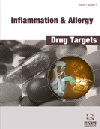- Home
- A-Z Publications
- Inflammation & Allergy-Drug Targets (Discontinued)
- Previous Issues
- Volume 10, Issue 6, 2011
Inflammation & Allergy-Drug Targets (Discontinued) - Volume 10, Issue 6, 2011
Volume 10, Issue 6, 2011
-
-
Commonalities and Differences Between Crohn's Disease and Ulcerative Colitis: The Genetic Clues to their Interpretation
More LessAuthors: Giovanni C. Actis, Rinaldo Pellicano, Sonia Tarallo and Floriano RosinaTraditional knowledge of clinical, laboratorial, and endoscopic orders regarding ulcerative colitis and Crohn's disease has begun to be implemented by the revolutionary data from genetic studies. Eversince many decades ago it has been clear that Inflammatory bowel diseases are complex multifactorial disorders wherein gut-confined and/or environmental factors must synergize with genetic components to effect the full-blo Read More
-
-
-
Damnacanthal-Induced Anti-Inflammation is Associated with Inhibition of NF-κB Activity
More LessMorinda citrifolia L. (Rubiaceae), commonly called noni, is a traditional folk medicinal plant with a long history of use for several diseases. Its anti-inflammation activity has been proposed, but detailed knowledge of this antiinflammation mechanism remains unclear. Here, we investigated the effects of noni extract and its major bioactive component damnacanthal on anti-inflammation in vivo as well as in vitro. Our data demon Read More
-
-
-
Impact of Sphingosine Kinase on Inflammatory Pathways in Fibroblast-Like Synoviocytes
More LessAuthors: DeAnna A. Baker, Lina M. Obeid and Gary S. GilkesonSphingolipids are mediators of inflammation; changes in their cellular concentration modulate specific cellular functions. Investigations of sphingosine kinases (SphK) and sphingosine 1 phosphate (S1P) in TNFα driven murine models of rheumatoid arthritis (RA), identified SphK/S1P as important intermediaries in TNFα mediated synovial proinflammatory pathways. Fibroblast-like synoviocytes (FLS) are key contributors t Read More
-
-
-
The Clinical Stage of Allergic Rhinitis is Correlated to Inflammation as Detected by Nasal Cytology
More LessAllergic rhinitis (AR) is the most common allergic disease. The Allergic Rhinitis and its Impact on Asthma (ARIA) guidelines classify AR according to its duration and severity and suggest recommended treatments, but there is evidence that these guidelines are insufficiently followed. Considering the validity of histopathological data, physicians are more likely to be persuaded by such information on AR. Thus, we attempted to defin Read More
-
-
-
Filaggrin in Atopic Dermatitis: Flaky Tail Mice as a Novel Model for Developing Drug Targets in Atopic Dermatitis
More LessAuthors: Catharina Sagita Moniaga and Kenji KabashimaThe barrier abnormality, a loss-of-function mutation in the gene encoding filaggrin (FLG), which is linked to the incidence of atopic dermatitis (AD), is a recently discovered but important factor in the pathogenesis of AD. To investigate this issue in greater detail, mice that have a genetic defect (FLG) in barrier function will provide a model of AD closer to the human disease. Flaky tail (Flgft) mice, essentially deficient in filaggrin, r Read More
-
-
-
The Pathology and Immunology of Atopic Dermatitis
More LessAuthors: Saifur Rahman, Mary Collins, Cara M. M. Williams and Hak-Ling MaAtopic dermatitis (AD) is a pruritic chronic inflammatory disease of the skin that is triggered by an underlying complicated interplay between the genetics of the individual and stimulation by allergens. Patients with AD demonstrate compromised barrier function that leads to activation of keratinocytes and immune cells which favor a strong Th2 bias. As a result of this immunological bias such patients also suffer from seco Read More
-
-
-
Aflibercept (VEGF-TRAP): The Next Anti-VEGF Drug
More LessThe inflammatory cytokine, vascular endothelial growth factor (VEGF), plays a central role in human growth and development, and vascular maintenance. VEGF mediated angiogenesis is essential for tumor growth, as well as exudative age-related macular degeneration, proliferative diabetic retinopathy and retinopathy of prematurity, all of which are characterized by abnormal neovascularization. Ischemia and inflam Read More
-
-
-
Modification of Chemokine Pathways and Immune Cell Infiltration as a Novel Therapeutic Approach in Liver Inflammation and Fibrosis
More LessAuthors: Henning W. Zimmermann and Frank TackeDespite increasing knowledge about molecular pathways in pathogenesis of chronic liver disease, selective therapeutic options are scarce, especially in advanced diseases characterized by scarring of the liver (termed fibrosis) or even complete cirrhosis. Sustained hepatic inflammation as a result to various types of injury (e.g., hepatitis C, nonalcoholic steatohepatitis) is generally accepted to represent the key prerequisit Read More
-
Most Read This Month
Article
content/journals/iadt
Journal
10
5
false
en


